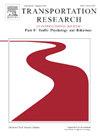An observational study of understanding the factors influencing merging behaviour in work zones
IF 3.5
2区 工程技术
Q1 PSYCHOLOGY, APPLIED
Transportation Research Part F-Traffic Psychology and Behaviour
Pub Date : 2025-02-01
DOI:10.1016/j.trf.2024.12.028
引用次数: 0
Abstract
Merging due to lane closure in work zones is an everyday driving activity that is characteristically different from merging in non-work zone sections. Despite many studies analysing merging behaviour in lane change situations, limited efforts explicitly aimed to understand work zone merging processes, particularly using real-world observational data and to distinguish behavioural patterns for different types of lane closure configurations. To fill these important gaps, this paper analyses merging behaviour in work zones featuring slow lane closure (SLC) and fast lane closure (FLC) using observational data from work zones in Australia. Merging behaviour in terms of merging locations, merging speed, and acceleration/deceleration rate during merging were examined using regression models. The results showed that work zone merging behaviour varied significantly among the SLC and FLC types of lane closure. In an SLC setup, most vehicles merged closer to the taper end, whereas most vehicles in an FLC setup merged well ahead of the taper start area. Traffic and vehicle characteristics, including vehicle type, type of vehicle in front, gap to the target lane lag vehicle, traffic volume, proportion of heavy vehicles, and order of a merging vehicle in a platoon, influenced merging behaviour across both types of sites. Traffic simulation and design of future work zone traffic controls should consider the insights developed on different merging behaviour and their influential factors in SLC and FLC setups.
了解影响工作区合并行为的因素的观察性研究
由于工作区域车道关闭导致的合并是一种日常驾驶活动,与非工作区域路段的合并有明显的不同。尽管有许多研究分析了变道情况下的合并行为,但明确旨在了解工作区合并过程的努力有限,特别是使用真实世界的观察数据,并区分不同类型车道关闭配置的行为模式。为了填补这些重要的空白,本文利用澳大利亚工作区的观测数据,分析了具有慢车道关闭(SLC)和快车道关闭(FLC)的工作区的合并行为。利用回归模型考察了归并过程中归并位置、归并速度和加减速率方面的归并行为。结果表明:不同车道封闭方式下,工作区合并行为差异显著;在SLC设置中,大多数车辆在更接近锥形末端的地方合并,而在FLC设置中,大多数车辆在锥形起始区域之前合并。交通和车辆特征,包括车辆类型、前面车辆类型、与目标车道滞后车辆的差距、交通量、重型车辆的比例以及队列中合并车辆的顺序,都会影响两种类型站点的合并行为。未来工作区交通管制的交通模拟和设计应考虑SLC和FLC设置中不同合并行为及其影响因素的见解。
本文章由计算机程序翻译,如有差异,请以英文原文为准。
求助全文
约1分钟内获得全文
求助全文
来源期刊
CiteScore
7.60
自引率
14.60%
发文量
239
审稿时长
71 days
期刊介绍:
Transportation Research Part F: Traffic Psychology and Behaviour focuses on the behavioural and psychological aspects of traffic and transport. The aim of the journal is to enhance theory development, improve the quality of empirical studies and to stimulate the application of research findings in practice. TRF provides a focus and a means of communication for the considerable amount of research activities that are now being carried out in this field. The journal provides a forum for transportation researchers, psychologists, ergonomists, engineers and policy-makers with an interest in traffic and transport psychology.

 求助内容:
求助内容: 应助结果提醒方式:
应助结果提醒方式:


